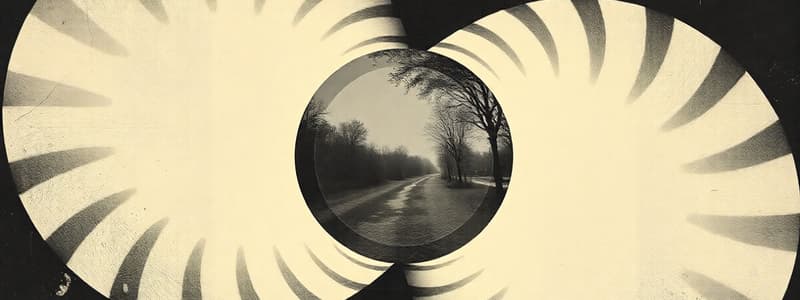Podcast
Questions and Answers
What does the term weightlessness actually imply about an astronaut in orbit?
What does the term weightlessness actually imply about an astronaut in orbit?
- The astronaut is experiencing negative acceleration.
- The astronaut is suspended in a complete vacuum.
- The astronaut is in a state of free fall. (correct)
- The astronaut is not experiencing any gravitational force.
Which scenario describes an environment of microgravity?
Which scenario describes an environment of microgravity?
- A roller coaster at its highest peak.
- A person sitting in a chair at home.
- An astronaut on the surface of Mars.
- Passengers in a freely falling elevator. (correct)
What is the significance of Cavendish's experiment?
What is the significance of Cavendish's experiment?
- It established that gravity does not affect small masses.
- It confirmed that weightlessness is possible in a vacuum.
- It provided the first accurate value for the universal gravitational constant. (correct)
- It demonstrated the relationship between mass and surface gravity.
What does the universal law of gravitation allow us to calculate about Earth?
What does the universal law of gravitation allow us to calculate about Earth?
Why do astronauts experience weightlessness on the International Space Station?
Why do astronauts experience weightlessness on the International Space Station?
Which statement about the gravitational constant G is true?
Which statement about the gravitational constant G is true?
How does blood pressure behave differently when standing compared to lying down?
How does blood pressure behave differently when standing compared to lying down?
Which of the following is NOT an effect of gravity on the human body?
Which of the following is NOT an effect of gravity on the human body?
What formula describes the gravitational force between two masses?
What formula describes the gravitational force between two masses?
Which statement about gravitational force is true?
Which statement about gravitational force is true?
How does the centripetal force relate to the motion of an object on a banked curve?
How does the centripetal force relate to the motion of an object on a banked curve?
What is the angle (θ) for a banked curve with a radius of 100m that should be negotiated without friction?
What is the angle (θ) for a banked curve with a radius of 100m that should be negotiated without friction?
What role does gravitational force play in the motion of the Moon around the Earth?
What role does gravitational force play in the motion of the Moon around the Earth?
What did Sir Isaac Newton contribute to the understanding of gravitational force?
What did Sir Isaac Newton contribute to the understanding of gravitational force?
What happens to the gravitational force if the distance between two masses is doubled?
What happens to the gravitational force if the distance between two masses is doubled?
In a scenario of a frictionless banked curve, the key factor in determining the angle of the bank is dependent on:
In a scenario of a frictionless banked curve, the key factor in determining the angle of the bank is dependent on:
What does the gravitational constant G represent in Newton's universal law of gravitation?
What does the gravitational constant G represent in Newton's universal law of gravitation?
Why does Earth experience tides as the Moon orbits it?
Why does Earth experience tides as the Moon orbits it?
What is primarily responsible for the formation of spring tides?
What is primarily responsible for the formation of spring tides?
How does the gravitational pull differ between the side of Earth facing the Moon and the far side?
How does the gravitational pull differ between the side of Earth facing the Moon and the far side?
What phenomenon creates the effect of weightlessness for an astronaut in orbit?
What phenomenon creates the effect of weightlessness for an astronaut in orbit?
In the equation $F = G \frac{mM}{r^2}$, what does the 'r' represent?
In the equation $F = G \frac{mM}{r^2}$, what does the 'r' represent?
What causes neap tides to occur?
What causes neap tides to occur?
If the mass of the Earth were to double while the Moon's mass remained constant, what would happen to the gravitational force between them?
If the mass of the Earth were to double while the Moon's mass remained constant, what would happen to the gravitational force between them?
Flashcards
Astronaut weightlessness
Astronaut weightlessness
Astronauts experience weightlessness in orbit because they are in free fall, accelerating with the acceleration due to gravity.
Microgravity
Microgravity
An environment where the apparent net acceleration of a body is small compared to Earth's surface gravity.
Blood pressure variation
Blood pressure variation
On Earth, blood pressure is higher in the feet than in the head due to gravity's effect on the blood column.
Weightlessness in amusement parks
Weightlessness in amusement parks
Signup and view all the flashcards
Cavendish experiment
Cavendish experiment
Signup and view all the flashcards
Universal gravitational constant
Universal gravitational constant
Signup and view all the flashcards
Earth's mass calculation
Earth's mass calculation
Signup and view all the flashcards
Newton's Law of Gravitation
Newton's Law of Gravitation
Signup and view all the flashcards
Newton's Law of Universal Gravitation
Newton's Law of Universal Gravitation
Signup and view all the flashcards
Gravitational Constant (G)
Gravitational Constant (G)
Signup and view all the flashcards
Earth's gravitational force on the moon
Earth's gravitational force on the moon
Signup and view all the flashcards
Ocean Tides
Ocean Tides
Signup and view all the flashcards
Spring Tides
Spring Tides
Signup and view all the flashcards
Neap Tides
Neap Tides
Signup and view all the flashcards
Weightlessness in Orbit
Weightlessness in Orbit
Signup and view all the flashcards
Banked Curve Speed
Banked Curve Speed
Signup and view all the flashcards
Ideal Banked Curve
Ideal Banked Curve
Signup and view all the flashcards
Centripetal Force
Centripetal Force
Signup and view all the flashcards
Gravitational Force
Gravitational Force
Signup and view all the flashcards
Center of Mass (CM)
Center of Mass (CM)
Signup and view all the flashcards
Speed of Ideal Banked Curve Formula
Speed of Ideal Banked Curve Formula
Signup and view all the flashcards
Gravity as a Force
Gravity as a Force
Signup and view all the flashcards
Study Notes
Uniform Circular Motion
- Uniform circular motion is movement in a circular path at constant speed.
- Pure rotational motion is when all points in an object move in circular paths centered on a single point.
- Pure translational motion is motion with no rotation.
Rotation Angle and Angular Velocity
- Kinematics studies motion along a straight line, including displacement, velocity, and acceleration.
- Uniform circular motion is described using angular quantities.
- Rotation angle is the ratio of arc length to the radius of curvature.
- ΔΘ = AS/r, where ΔΘ is the rotation angle, AS is the arc length, and r is the radius.
- One complete revolution has a rotation angle of 2π radians.
- 1 radian is equal to approximately 57.3 degrees
- Angular velocity (ω) is the rate of change of an angle: ΔΘ / Δt.
Angular Velocity
- Describes how fast an object rotates.
- ω = ΔΘ / Δt, where ω is angular velocity, ΔΘ is the change in angle, and Δt is the change in time.
- Radians per second (rad/s) are the units of angular velocity.
- Greater change in angle in a given time means greater angular velocity.
Relationship Between Angular and Linear Velocity
- Linear velocity (v) is the rate of change of arc length: AS/ Δt.
- v = rω, where v is linear velocity, r is the radius and ω is angular velocity.
- Linear velocity is proportional to the distance from the center of rotation, so the largest velocity will be on the rim (outer edge) of a rotating object.
Centripetal Acceleration
- Acceleration is a change in velocity, in magnitude or direction, or both.
- In uniform circular motion, the direction of velocity changes constantly, meaning there is always acceleration.
- This acceleration is called centripetal acceleration (ac).
- Centripetal acceleration points directly toward the center of rotation.
- Magnitude of centripetal acceleration: ac = v²/r = rω². (v is linear velocity, r is radius, ω is angular velocity)
Centripetal Force
- Any force that causes uniform circular motion is called a centripetal force.
- Centripetal force points toward the center of curvature, same direction as centripetal acceleration.
- Fc = mac = mv²/r = mrω². (Fc is centripetal force, m is mass, a is acceleration, v is linear velocity, r is radius, ω is angular velocity)
- Centripetal force is always perpendicular to the path and to the velocity, pointing to the center of curvature.
Banked Curves
- Road banking helps negotiate curves without friction.
- Greater bank angles allow for faster speeds.
- "ideally banked curve," the angle is such that a vehicle can negotiate the curve at a certain speed without the assistance of friction.
- For ideal banking, the net external force is equal to the horizontal centripetal force in the absence of friction.
- The components of the normal force in the horizontal and vertical directions must equal the centripetal force and the weight of the object, respectively
- N sin θ = mv²/r and N cos θ = mg where N is the normal force, θ is banking angle, m is mass, v is speed, r is radius, and g is acceleration due to gravity.
Newton's Universal Law of Gravitation
- Gravity is a fundamental force, acting at a distance.
- It's the weakest force in nature.
- All objects in the universe attract each other.
- The force is directly proportional to the product of the masses and inversely proportional to the square of the distance: F = G(mM/r^2), where G is the universal gravitational constant, m and M are the masses, and r is the distance.
- G ≈ 6.674 x 10⁻¹¹ N⋅m²/kg².
Tides
- Ocean tides are a result of the Moon's gravitational pull.
- A high tide is on the side of Earth facing the Moon because the gravitational pull is strongest there.
- There is also a high tide on the opposite side of Earth. This occurs because Earth is pulled more strongly toward the Moon than the water is, which is further away.
- Earth's rotation leads to two high tides and two low tides per day.
- The sun also affects tides, though less significantly than the moon. Spring tides occur when the Earth, Moon, and Sun are aligned, leading to larger tidal ranges. Neap tides occur when the Sun is at a 90-degree angle to the Earth-Moon alignment, leading to smaller tidal ranges.
Weightlessness and Microgravity
- Weightlessness is experienced when the apparent net acceleration of an object is very small compared to that produced by Earth at its surface.
- It's not the absence of gravitational force. It's a state where the gravitational force produces the acceleration in freefall.
- When standing, most of your blood is below your heart, but in a horizontal position the opposite is true.
- Microgravity is found in space.
Cavendish Experiment
- Experiment conducted to determine the universal gravitational constant(G).
- Measured tiny gravitational attraction between ordinary-sized masses.
- Determined the value of G to high accuracy.
Studying That Suits You
Use AI to generate personalized quizzes and flashcards to suit your learning preferences.




